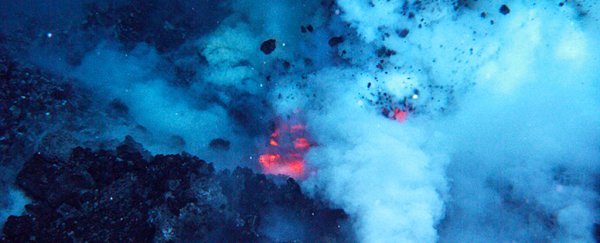The ocean floor is famously unexplored and is imaged in much less detail than the surfaces of Mars, the Moon and Venus.
Draining the water from the oceans would reveal a vast and mostly unknown volcanic landscape. In fact, the majority of Earth’s volcanic activity occurs underwater and at depths of several kilometers in the deep ocean.
But in contrast to terrestrial volcanoes, even detecting that an eruption has occurred on the seafloor is extremely challenging.
Consequently, there remains much for scientists to learn about submarine volcanism and its role in the marine environment.
Now our new study on deep-sea eruptions, published in Nature Communications, gives important insights.
Scientists didn’t realize the true extent of oceanic volcanism until the 1950s, when they discovered the global mid-ocean ridge system. This finding was pivotal to the theory of plate tectonics. The network of volcanic ridges runs more than 60,000 kilometers around the globe.
Subsequent exploration led to the detection of “black smoker” vents, where mineral-rich “hydrothermal” fluids (heated water in Earth’s crust) are ejected into the deep ocean.
Driven by heat from the underlying magma, these systems influence the chemistry of the entire oceans. The vents also host “extremophiles” – organisms that survive in extreme environments that were once thought to be unable to sustain life.
But many questions remain. It has long been thought that deep-sea eruptions themselves are rather uninteresting compared to the variety of eruptive styles observed on land.
Terrestrial volcanoes that produce similar types of magma to those on the seafloor, such as in Hawaii or Iceland, often produce spectacular explosive eruptions, dispersing volcanic ash (called tephra). This type of eruption was thought to be highly improbable in the deep ocean due to the pressure from the overlying water.
But data collected via remotely operated submarine vehicles has shown that tephra deposits are surprisingly common on the seafloor. Some marine micro-organisms (foraminifera) even use this volcanic ash to construct their shells.
These eruptions are probably driven by expanding bubbles of carbon dioxide. Steam, which is largely responsible for explosive eruptions on land, cannot form at high pressures.
Scientists have also sporadically detected massive regions of hydrothermal fluid in the ocean above volcanic ridges. These enigmatic regions of heated, chemical-rich water are known as megaplumes.
Their size is truly immense, with volumes that can exceed 100 cubic kilometers – equivalent to over 40 million Olympic swimming pools.
But while they seem to be linked to seafloor eruptions, their origin has remained a mystery.
Megaplumes mystery
In our study, we used a mathematical model to explain the dispersal of submarine tephra through the ocean. Thanks to detailed mapping of a volcanic ash deposit in the north-east Pacific, we know that this tephra can spread up to several kilometers from the site of an eruption.
This cannot be explained easily by tides or other oceanic currents. Our results instead suggest that the plumes must be highly energetic. Like the atmospheric plumes seen at terrestrial volcanoes, these initially rise upwards through the water before spreading out horizontally.
The heat transfer required to drive this flow, and carry the tephra with it, is surprisingly large at around one terawatt (double that required to power the entire USA at once). We calculated that this should create plumes of a similar size that has indeed been measured.
Our work provides strong evidence that megaplumes are linked to active seafloor eruptions and that they form very rapidly, probably in a matter of hours.
So, what is the specific source of this intense input of heat and chemicals that ultimately creates a megaplume? The most obvious candidate is of course the freshly erupted molten lava. At first glance, our results seemed to support such a hypothesis.
They show that megaplume formation occurs concurrently with the eruption of lava and tephra. But when we calculated the amount of lava required for this it was unrealistically high, around ten times greater than most submarine lava flows.
Our best guess for now is that, while megaplume creation is closely linked to seafloor eruptions, they primarily owe their origin to the emptying of reservoirs of hydrothermal fluids that are already present within the ocean crust. As magma forces its way upwards to feed seafloor eruptions, it may drive this hot (>300°C) fluid with it.
Extreme life
We now know that diverse microorganisms live in rocks below the surface. As startling as the discovery of extremophile lifeforms around hydrothermal vents was, this discovery pushed our ideas of what life is, and where it might exist, even further.
The fact that our research suggests that megaplumes come from the crust is consistent with the detection of such bacteria within some megaplumes.
The rapid outpouring of fluids associated with megaplume formation may actually be the primary mechanism that disperses these microorganisms from their subterranean origin. If so, then deep-sea volcanic activity is an important factor influencing the geography of these extremophile communities.
Some scientists believe that the unusual physical and chemical conditions associated with seafloor hydrothermal systems may have provided a suitable environment for the origin of life on Earth. Megaplumes may therefore have been involved in spreading this life across the ocean.
If life is to be found elsewhere in our solar system then hydrothermal vents, such as those thought to exist on Saturn’s moon Enceladus, would be a good place to look.
In the absence of other sources of nutrients and light, these types of organisms – possibly the first to exist on our planet – owe their existence to the heat and chemicals supplied by the magma that rises upwards to feed seafloor volcanoes.
Since megaplume-transported volcanic ash deposits seem to be common at deep sea volcanoes, the results of our research suggest that the proliferation of life through megaplume emissions may be widespread.
While being able to observe a deep-sea eruption in person remains unlikely for now, efforts are being made to collect data on submarine volcanic events.
The most notable of these is the observatory at Axial Volcano in the Pacific. This array of seafloor instruments can stream data in real time, capturing events as they happen.
Through efforts like these, in concert with continued mapping and sampling of the ocean floor, the volcanic character of the oceans is slowly being revealed.
David Ferguson, Research Fellow in volcanic processes, University of Leeds and Sam Pegler, University Academic Fellow in Applied Mathematics, University of Leeds.
This article is republished from The Conversation under a Creative Commons license. Read the original article.



